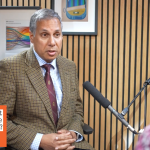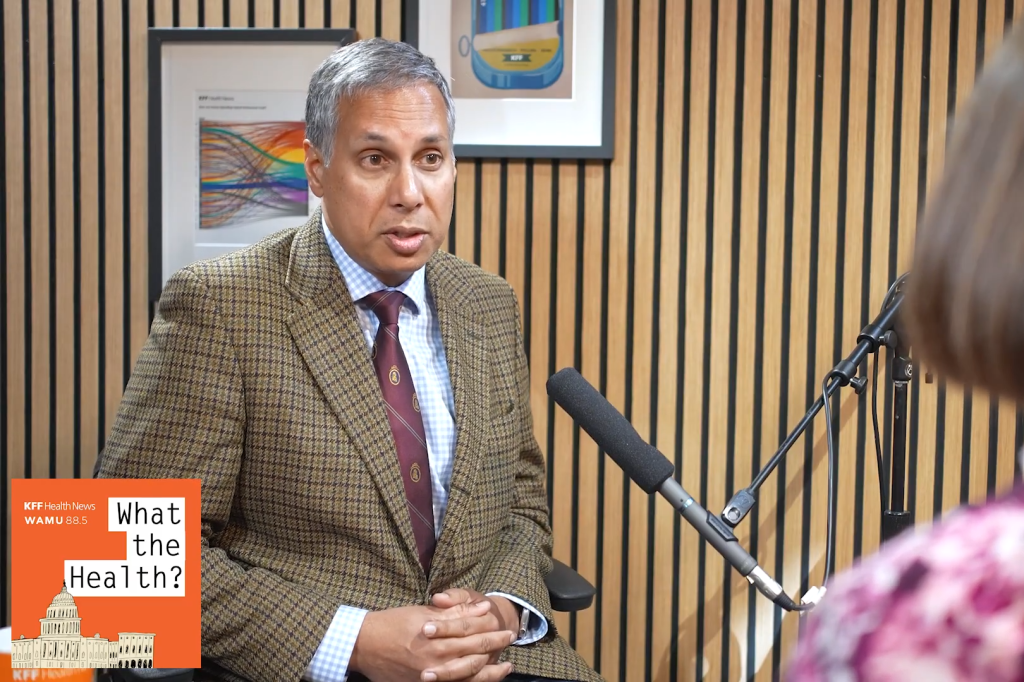When Lawrence and Penny Higgins of Fairfield, Maine, first learned in 2020 that high levels of toxic chemicals called PFAS taint their home’s well water, they wondered how their health might suffer. They had consumed the water for decades, given it to their pets and farm animals, and used it to irrigate their vegetable garden and fruit trees.
“We wanted to find out just what it’s going to do to us,” Penny Higgins said. They contacted a couple of doctors, but “we were met with a brick wall. Nobody knew anything.”
Worse still, she added, they “really didn’t want to hear about it.”
Many clinicians remain unaware of the health risks linked to PFAS, short for perfluoroalkyl and polyfluoroalkyl substances, despite rising medical and public awareness of the chemicals and their toxicity. PFAS can affect nearly every organ system and linger in bodies for decades, raising risks of cancer, immune deficiencies, and pregnancy complications.
These “forever chemicals” have been widely used since the 1950s in products including cosmetics, cookware, clothing, carpeting, food packaging, and firefighting foam. Researchers say they permeate water systems and soils nationwide, with a federal study estimating that at least 45% of U.S. tap water is contaminated. PFAS can be detected in the blood of nearly all Americans, according to the Centers for Disease Control and Prevention.
Maine was among the first states to begin extensive water and soil testing and to try to limit further public exposure to PFAS through policy action, after discovering that farms and residences — like the Higgins’ property — had been contaminated by land-spreading of wastewater sludge containing PFAS. Exposure can also be high for people living near military bases, fire training areas, landfills, or manufacturing facilities.
In regions where testing reveals PFAS hot spots, medical providers can be caught flat-footed and patients left adrift.
Rachel Criswell, a family practice doctor and environmental health researcher, is working to change that. She was completing her residency in Central Maine around the time that the Higginses and others there began discovering the extent of the contamination. Her medical training at Columbia University included more than a year in Norway researching the effects of PFAS and other chemicals on maternal and infant health.
When patients began asking about PFAS, Criswell and the state toxicologist offered primary care providers lunchtime presentations on how to respond. Since then, she has fielded frequent PFAS questions from doctors and patients throughout the state.
Even knowledgeable providers can find it challenging to stay current given rapidly evolving scientific information and few established protocols. “The work I do is exhausting and time-consuming and sometimes frustrating,” Criswell said, “but it’s exactly what I should be doing.”
Phil Brown, a Northeastern University sociology professor and a co-director of the PFAS Project Lab, said the medical community “doesn’t know a lot about occupational and environmental health,” adding that “it’s a very minimal part of the medical school curriculum” and continuing education.
Courtney Carignan, an environmental epidemiologist at Michigan State University, said learning of PFAS exposure, whether from their drinking water or occupational sources, “is a sensitive and upsetting situation for people” and “it’s helpful if their doctors can take it seriously.”
Clinical guidance concerning PFAS improved after the National Academies of Sciences, Engineering, and Medicine released a report on PFAS in 2022. It found strong evidence associating PFAS with kidney cancer, high cholesterol, reduced birth weights, and lower antibody responses to vaccines, and some evidence linking PFAS to breast and testicular cancer, ulcerative colitis, thyroid and liver dysfunction, and pregnancy-induced hypertension.
That guidance “revolutionized my practice,” Criswell said. “Instead of being this hand-wavey thing where we don’t know how to apply the research, it brought a degree of concreteness to PFAS exposure that was kind of missing before.”
The national academies affirmed what Criswell had already been recommending: Doctors should order blood tests for patients with known PFAS exposures.
Testing for PFAS in blood — and for related medical conditions if needed — can help ease patients’ anxiety.
“There isn’t a day that goes by,” Lawrence Higgins said, “that we don’t think and wonder when our bodies are going to shut down on us.”
‘Devastating but Incredibly Helpful’
After finding out in 2021 that his family was exposed to PFAS through sludge spread on their Unity, Maine, farm decades earlier, Adam Nordell discovered that “it was exceedingly difficult” to get tested. “Our family doctor had not heard of PFAS and didn’t know what the test was,” he said. A lab technician needed coaching from an outside expert to source the test. The lab analyzing the samples had a backlog that left the family waiting three months.
“The results were devastating but incredibly helpful,” Nordell said. Their blood serum levels for PFAS were at roughly the 99th percentile nationally, far higher than their well-water levels would have predicted — indicating that additional exposure was probably coming from other sources such as soil contact, dust, and food.
Blood levels of PFAS between 2 and 20 nanograms per milliliter may be problematic, the national academies reported. In highly contaminated settings, blood levels can run upward of 150 times the 20-ng/mL risk threshold.
Nordell and his family had been planning to remain on the farm and grow crops less affected by PFAS, but the test results persuaded them to leave. “Knowledge is power,” Nordell said, and having the blood data “gave us agency.”
Related Articles
Future of Cancer Coverage for Women Federal Firefighters Uncertain Under Trump
Feb 28, 2025
‘Forever Chemicals’ Found in Freshwater Fish, Yet Most States Don’t Warn Residents
Dec 1, 2023
Toxic ‘Forever Chemicals’ Taint Rural California Drinking Water, Far From Known Sources
Dec 11, 2024
The national academies’ guidance paved the way for more clinicians to order PFAS blood tests. The cost, typically $400 to $600, can be prohibitive if not picked up by insurance, and not all insurers cover the testing. Deductibles and copays can also limit patients’ capacity to get tested. Less costly finger-prick tests, administered at home, appear to capture some of the more commonly found PFAS as accurately as blood serum tests, Carignan and colleagues found.
Maine legislators recently passed, with overwhelming support, a bill — modeled after one in New Hampshire — that would require insurers to consider PFAS blood testing part of preventive care, but it was carried over to the next legislative session.
“In my mind, it’s a no-brainer that the PFAS blood serum test should be universally offered — at no cost to the patient,” said Nordell, who now works as a campaign manager for the nonprofit Defend Our Health. Early screening for the diseases associated with PFAS, he said, is “a humane policy that’s in the best interests of everyone involved” — patients, providers, and insurance companies.
Criswell tells colleagues in family practice that they can view elevated PFAS blood levels as a risk factor, akin to smoking. “What’s challenging as a primary care doctor is the nitty-gritty” of the testing and screening logistics, she said.
In trainings, she shares a handout summarizing the national academies’ guidance — including associated heath conditions, blood testing, clinical follow-up, and exposure reduction — to which she has added details about lab test order codes, insurance costs and coverage, and water filtration.
Criswell served on an advisory committee tasked with allocating $60 million in state funds to address PFAS contamination from past sludge-spreading in Maine. The group recommended that labs analyzing PFAS blood tests should report the results to state public health authorities.
That change, slated to take effect this summer, will allow Maine health officials to follow up with people who have high PFAS blood levels to better determine potential sources and to share information on health risks and medical screening. As with many earlier PFAS policies, Maine is among the first states to adopt this measure.
Screening for PFAS is falling short in many places nationwide, said Kyle Horton, an internist in Wilmington, North Carolina, and founder of the nonprofit On Your Side Health. She estimates that only about 1 in 100 people facing high PFAS exposure are getting adequate medical guidance.
Even in her highly contaminated community, “I’m not aware of anyone who is routinely screening or discussing PFAS mitigation with their patients,” Horton said. Knowledge of local PFAS threats, she added, “hasn’t translated over to folks managing patients differently or trying to get through to that next phase of medical monitoring.”
Patients as Advocates
In heavily affected communities — including in Michigan, Maine, and Massachusetts — patients are pushing the medical field to better understand PFAS.
More doctors are speaking out as well. Testifying before a Maine legislative committee this year in support of a bill that would limit occupational PFAS exposure, Criswell said, “We, as physicians, who are sworn to protect the health of our patients, must pay attention to the underlying causes of the illnesses we treat and stand up for policy solutions that reduce these causes.”
Even where policy changes are instituted, the physical and psychological toll of “forever chemicals” will extend far into the future. Criswell and other Maine doctors have observed chronic stress among patients.
Nordell, the former farmer, described his family’s contamination as “deeply, deeply jarring,” an ordeal that has at times left him “unmoored from a sense of security.”
To assess the mental health consequences of PFAS exposure in rural residents, Criswell and Abby Fleisch, a pediatric endocrinologist at the MaineHealth Institute for Research, teamed up on a study. In its first phase, winding up this summer, they collected blood samples and detailed lifestyle information from 147 people.
Nordell, the Higginses, and other Central Maine residents sit on an advisory board for the study, a step Criswell said was critical to ensuring that their research helps those most affected by PFAS.
“The urgency from the community is really needed,” she said. “I don’t think I would be as fired up if my patients weren’t such good advocates.”
Criswell has faced what she calls “cognitive dissonance,” caught between the deliberate pace of peer-reviewed medical research and the immediate needs of patients eager to lower their PFAS body burden. Initially she considered inviting residents to participate in a clinical trial to test therapies that are considered safe and may help reduce PFAS levels in the body, such as high-fiber diets and a drug designed to reduce cholesterol called cholestyramine. But the clinical trial process could take years.
Criswell and Fleisch are instead planning to produce a case series on PFAS blood-level changes in patients taking cholestyramine. “We can validate the research results and share those,” Criswell said, potentially helping other patients.
Alan Ducatman, an internist and occupational physician who helped design the largest PFAS cohort study to date, said providers should convey that “there is no risk-benefit analysis” for any of the current treatments, although they’re generally well known and low-risk.
“Some people want to be treated, and they should be allowed to be treated,” he said, because knowing they have high PFAS levels in their bodies “preys on them.”
KFF Health News is a national newsroom that produces in-depth journalism about health issues and is one of the core operating programs at KFF—an independent source of health policy research, polling, and journalism. Learn more about KFF.
USE OUR CONTENT
This story can be republished for free (details).










